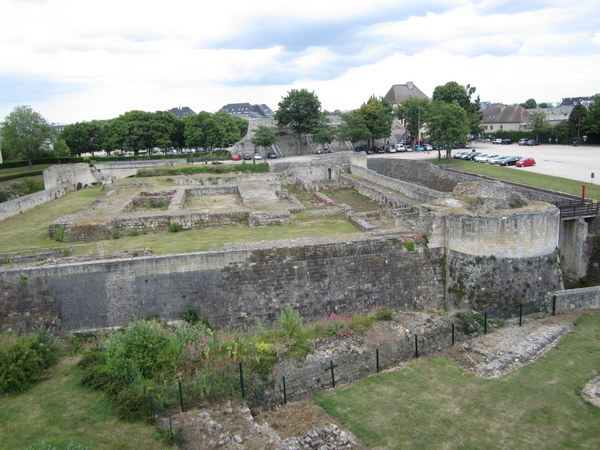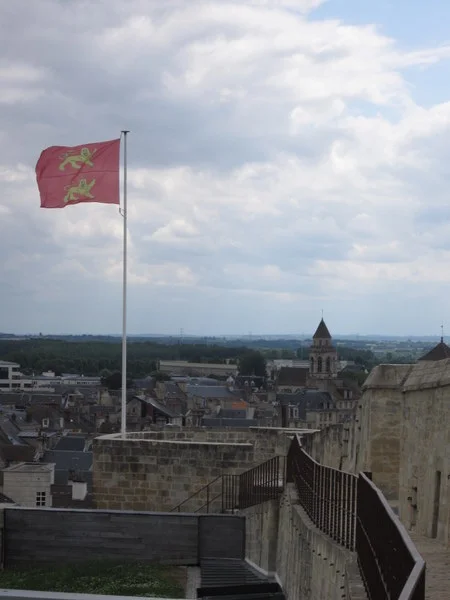Tuesday Afternoon June 7, 2011
After my taxi, Anne Brard, got me safely back to the Hotel Mercure Caen from Falaise, I had a quick lunch, then toured the Chateau at Caen. The chateau is where Bill the Bastard and Matilda spent some of their time. It was built by Bill around 1060, before he went on to conquer England and become King William I. His son, Henry I added a church and a keep in 1123, then a large ducal hall sometime later. Another interesting factoid specifially for Eleanor of Aquitaine fans like me is that this castle was the site of the Christmas court in 1182 during which Henry II, William I's great grandson and Eleanor's husband, was reunited with his sons Richard the Lionheart and John Lackland, as well as the Young King, Prince Henry (who was to die of a battle wound the very next year). More than a thousand knights were in attendance, but was Eleanor? No. The record does not say explicitly, but she was likely still locked in her tower in Winchester, England.
The foundation of the Caen fortress in ruins. It covers about 14 acres.
The ruins of Caen castle lie northeast of the modern town center. The fortification was massive. It is the largest one of its kind in Europe, covering almost 14 acres. The fortress used to sit on an isolated hill, but now is surrounded by the city of Caen. As I approached, a red flag with the two golden lions representing William I, who was known as the lion, rippled in the breeze over the curtain walls. Why two lions, though? One lion represents the Kingdom of England. The other, the Duchy of Normandy, which William still ruled in addition to all of England. A third lion was added to the dynasty's banner most likely during Eleanor's son Richard the Lionheart's reign to represent the lands of Aquitaine.
The flag of William I, the lion, in Caen, France.
The castle and fortifications are in bad shape, but not just because of the travails of the middle ages. In 1204, the French, led by Philip II, captured the castle and reinforced it's walls. The castle then made it through the Hundred Years War, but the keep was pulled down during the French Revolution. In 1944, the castle, then being used as a barracks, was bombed. In 1946 a local architect named Michel de Boüard started excavating the area and established the Musée des Beaux-Arts on site. The fortress also now houses the Musée de Normandie.
Love the colors in the stone "streets" of the fortress at Caen.
I did not visit either museum, but I did walk around inside the fort along the cobbled streets. The French really know how to make their ruins pop. The beauty of the old stone is set off by the crimson door at the entrance to the castle, as well as the pink, gray, and orange shades of the cobbles.
The Échiquier de Normandie inside the walls of the fortress at Caen.
One of the places that intrigued me was the Échiquier de Normandie or the Exchequer of Normandy. It has served as a temporary hall of exhibitions, but used to be the seat of the Court of Normandy. In fact, the Christmas court of 1182 was probably held exactly here. At one side of the building was a stair down to the lower level barred by a chain. The door at the bottom of the stair was just an iron grate, and it too was locked with a chain. The whole thing was surrounded by vertical metal bars. All I could think of was a sheriff's jail.
Did the the Exchequer of Normandy house a jail in the basement?
I walked the ramparts and enjoyed a panoramic view of the city. I was sad that the keep had been leveled, but I could still see the foundations of the buildings which existed no longer. And I had the sense of the immensity of the fortifications.
A view of downtown Caen from the ramparts of the fortress.
Before I returned to my hotel room to get ready for dinner, I decided to check out the archaeological dig Anne Brard had told me about. Some new construction had unveiled a crypt or the foundation of an old building in the modernized downtown.
An archeologist/professor lecturing the crowd at a just-discovered Roman site in the center of Caen, June 2011.
I hiked to the center of Caen. A huge area in the center of a traffic circle, which had been parking lot, was roped off. Roman ruins had been discovered underneath it just before I arrived. I couldn't get access to the dig, and no one nearby spoke English. An archaeologist, perhaps a professor from the local university, was standing behind the rope giving an ad hoc lecture to the crowd, in French. She stood next to a big rectangular hole in the ground. It looked like it might have been a Roman bath. I have been unable to find any details about this specific site. The Romans conquered the area that is now Normandy around 98 AD and the region was integrated into the province of Gallia Lugdunensis by Augustus. During construction of a highway around the mid 2000s, ruins of Roman villas were found. These villas each had their own heating system called a hypocaust, which was built under the main floor of the house. Maybe this ruin in downtown Caen was a hypocaust as well.
Hypocaust under the floor in a Roman villa in Vieux-la-Romaine, near Caen, France in January 2006 by Valdavia - Own work, CC BY-SA 3.0
During my stay at the hotel in Caen, I was accosted by a flying insect. While I was sleeping, I was bit on and near my left eye on two successive nights. It is funny how I made no note of it in my journal or my posts from that time. It was my fault. The afternoon I arrived at the hotel, I opened the window in my room because of the lovely breeze off the port. Unfortunately, there was no screen and a black fly of some sort—probably a horse fly--got into my room and hid itself. When I returned to my room after dinner, the air had cooled so I closed the window. Then I did the usual writing and reviewing plans for the next day. Finally I went to bed and fell asleep. Some time in the early morning hours, that fly came out from hiding and bit me on the eyelid and the side of my face near my eye. I was annoyed but not concerned. When I woke again the next morning, my eye was red, but I went about my business. After a long day of touring I went to bed without a thought of the fly from the night before. Again unfortunately, the fly was not done. He came back and bit me again in the lower lid of the same eye! The next morning my eye was even redder and now quite swollen. And itchy. I tried really hard to not scratch it, but that proved impossible. My eye remained irritated for several days. Finally, I decided to call the Travel Guard people who were handling the insurance for my trip and get a list of ophthalmologists in their network, just in case. It worked great. The Insurance people emailed me a list and I never had to use it. My eye slowly healed and I forgot all about the incident after about a week and a half when my eye returned to normal. A selfie from June 14 clearly shows an irritated red bump in the corner of my eye. (No, I am not going to show that to you here. You will just have to wait to see that photo when that part of the travelogue is revealed!)
Additional References:
Wikipedia entry on the History of Normandy
Wikipedia entry on the Château de Caen
Alison Weir, Eleanor of Aquitaine, Ballantine Publishing Group, 1999.








